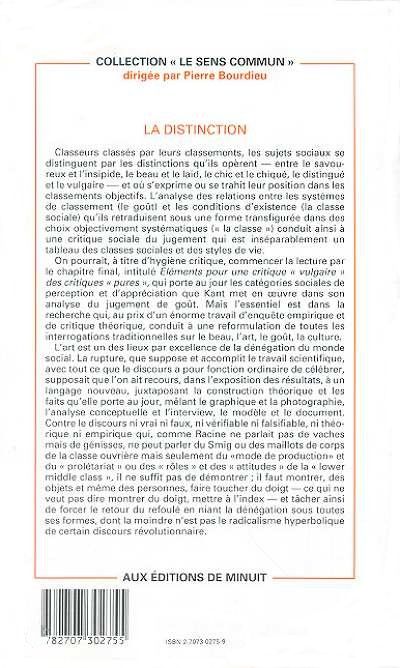


However, Bourdieu does not disregard the importance of social capital and economic capital in the formation of cultural capital. A multitude of consumer interests based on differing social positions necessitates that each fraction “has its own artists and philosophers, newspapers and critics, just as it has its hairdresser, interior decorator, or tailor.” Each fraction of the dominant class develops its own aesthetic criteria.

Bourdieu claims that “one has to take account of all the characteristics of social condition which are (statistically) associated from earliest childhood with possession of high or low income and which tend to shape tastes adjusted to these conditions.”Īccording to Bourdieu, tastes in food, culture and presentation are indicators of class because trends in their consumption seemingly correlate with an individual’s fit in society. He asserts the primacy of social origin and cultural capital by claiming that social capital and economic capital, though acquired cumulatively over time, depend upon it. The acquisition of cultural capital depends heavily on “total, early, imperceptible learning, performed within the family from the earliest days of life.” Bourdieu argues that, in the main, people inherit their cultural attitudes, the accepted “definitions that their elders offer them.” The development of aesthetic dispositions are very largely determined by social origin rather than accumulated capital and experience over time. He emphasizes the dominance of cultural capital early on by stating that “differences in cultural capital mark the differences between the classes.”

Society incorporates “symbolic goods, especially those regarded as the attributes of excellence, the ideal weapon in strategies of distinction.” Those attributes deemed excellent are shaped by the interests of the dominating class. Class fractions are determined by a combination of the varying degrees of social, economic, and cultural capital. Specifically, Bourdieu hypothesizes that these dispositions are internalized at an early age and guide the young towards their appropriate social positions, towards the behaviors that are suitable for them, and an aversion towards other behaviors.īourdieu theorizes that class fractions teach aesthetic preferences to their young. Bourdieu claims that how one chooses to present one’s social space to the world - one’s aesthetic dispositions - depicts one’s status and distances oneself from lower groups. Pierre Bourdieu developed theories of social stratification based on aesthetic taste in his 1979 work Distinction: A Social Critique of the Judgment of Taste (in French, La Distinction) published by Harvard University Press.


 0 kommentar(er)
0 kommentar(er)
